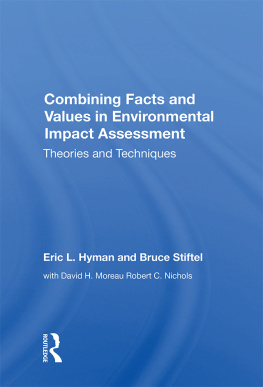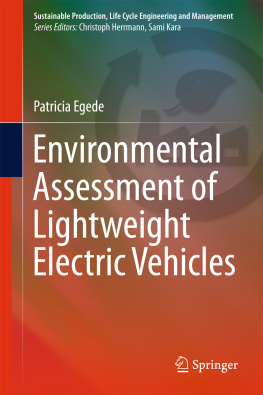Eric L. Hyman - Combining Facts and Values in Environmental Impact Assessment: Theories and Techniques
Here you can read online Eric L. Hyman - Combining Facts and Values in Environmental Impact Assessment: Theories and Techniques full text of the book (entire story) in english for free. Download pdf and epub, get meaning, cover and reviews about this ebook. year: 2020, publisher: Taylor & Francis Group, genre: Politics. Description of the work, (preface) as well as reviews are available. Best literature library LitArk.com created for fans of good reading and offers a wide selection of genres:
Romance novel
Science fiction
Adventure
Detective
Science
History
Home and family
Prose
Art
Politics
Computer
Non-fiction
Religion
Business
Children
Humor
Choose a favorite category and find really read worthwhile books. Enjoy immersion in the world of imagination, feel the emotions of the characters or learn something new for yourself, make an fascinating discovery.
- Book:Combining Facts and Values in Environmental Impact Assessment: Theories and Techniques
- Author:
- Publisher:Taylor & Francis Group
- Genre:
- Year:2020
- Rating:5 / 5
- Favourites:Add to favourites
- Your mark:
- 100
- 1
- 2
- 3
- 4
- 5
Combining Facts and Values in Environmental Impact Assessment: Theories and Techniques: summary, description and annotation
We offer to read an annotation, description, summary or preface (depends on what the author of the book "Combining Facts and Values in Environmental Impact Assessment: Theories and Techniques" wrote himself). If you haven't found the necessary information about the book — write in the comments, we will try to find it.
Eric L. Hyman: author's other books
Who wrote Combining Facts and Values in Environmental Impact Assessment: Theories and Techniques? Find out the surname, the name of the author of the book and a list of all author's works by series.
Combining Facts and Values in Environmental Impact Assessment: Theories and Techniques — read online for free the complete book (whole text) full work
Below is the text of the book, divided by pages. System saving the place of the last page read, allows you to conveniently read the book "Combining Facts and Values in Environmental Impact Assessment: Theories and Techniques" online for free, without having to search again every time where you left off. Put a bookmark, and you can go to the page where you finished reading at any time.
Font size:
Interval:
Bookmark:
with David H. Moreau
Robert C. Nichols

52 Vanderbilt Avenue, New York, NY 10017
2 Park Square, Milton Park, Abingdon, Oxon OX14 4RN
Product or corporate names may be trademarks or registered trademarks, and are used only for identification and explanation without intent to infringe.
Hyman, Eric.
Combining facts and values in environmental impact
assessment.
(Social impact assessment; 16)
1. Economic development--Environmental aspects--Cost
effectiveness. 2. Natural resources--Cost effectiveness.
3. Environmental impact analysis--Cost effectiveness.
I. Stiftel, Bruce. II. Title. III. Series: Social
impact assessment series; no. 16)
HD75.6.H95 1988 333.71 85-26630
- AEA --- Adaptive environmental assessment and management process
- CEQ --- U.S. Council on Environmental Quality
- EES --- Environmental evaluation system
- EIS --- Environmental Impact Statement
- EQA --- Environmental quality assessment method
- HEP --- Habitat evaluation procedures
- KSIM --- Kane simulation method
- METLAND --- Metropolitan landscape planning model
- NEPA --- National Environmental Policy Act
- PAG --- Policy Advisory Group
- PEQIs --- Perceived environmental quality indicators
- PVNB --- Present value of net benefits
- SAGE --- Social Judgement Capturing--Adaptive--Goals--Achievement--Environmental assessment
- SWT --- Surrogate-worth tradeoff approach
- TJCOG --- Triangle J Council of Governments (North Carolina)
- WES --- Wetland evaluation system
- WPTF --- Watershed planning task force
- WRAM --- Water resources assessment method
- WTA --- Willingness-to-accept compensation measure
- WTP --- Willingness-to-pay measure
Bruce Stiftel
Font size:
Interval:
Bookmark:
Similar books «Combining Facts and Values in Environmental Impact Assessment: Theories and Techniques»
Look at similar books to Combining Facts and Values in Environmental Impact Assessment: Theories and Techniques. We have selected literature similar in name and meaning in the hope of providing readers with more options to find new, interesting, not yet read works.
Discussion, reviews of the book Combining Facts and Values in Environmental Impact Assessment: Theories and Techniques and just readers' own opinions. Leave your comments, write what you think about the work, its meaning or the main characters. Specify what exactly you liked and what you didn't like, and why you think so.






